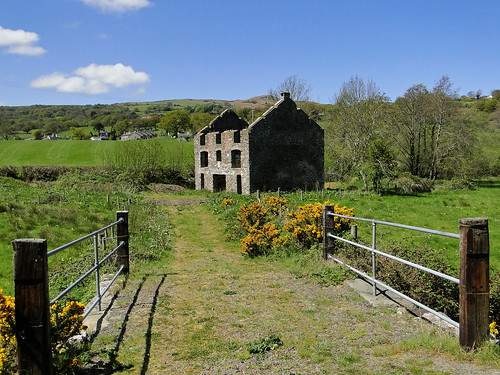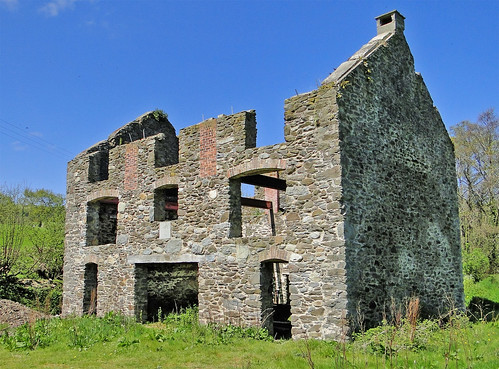Although it looks like a traditional mill, this building by the Gyffin stream on the Henryd Road in Conwy was actually a Candle Factory. It was established in the late 19th Century to make tallow candles (they apparently drip significantly less than wax candles), mainly to supply candles to the miners in the numerous local lead mines.
Animal fat was collected from several slaughterhouses in the area by the owner, Owen Owen (and later Llywelyn Evans), melted down and then poured into dipping troughs. The wicks were attached to a rod hanging above the trough and then dipped into the fat until the required thickness was reached. Unfortunately, the early years of the 20th century brought a decline in local mining, the introduction of oil lamps and the onset of electricity - all of which sent the candle business into steep decline. The mill eventually closed around the time of World War I and appears to have been abandoned ever since.
Some stabilisation of the building was carried out by its owner, Daffydd Roberts, a local farmer, in around 2004/5 but there appears to be no plans to bring the building back into use. Without a roof to protect the structure, its long term survival appears uncertain.
I think it would make a great artist's gallery or a set of small craft workshops, maybe even including a candle maker?
Thanks to Stan Whittaker and Christopher Draper for the information used in this post. Christopher Draper has a great book called 'Walks From Conwy', which combine a series of gentle walks with lots of historical information.
Animal fat was collected from several slaughterhouses in the area by the owner, Owen Owen (and later Llywelyn Evans), melted down and then poured into dipping troughs. The wicks were attached to a rod hanging above the trough and then dipped into the fat until the required thickness was reached. Unfortunately, the early years of the 20th century brought a decline in local mining, the introduction of oil lamps and the onset of electricity - all of which sent the candle business into steep decline. The mill eventually closed around the time of World War I and appears to have been abandoned ever since.
Some stabilisation of the building was carried out by its owner, Daffydd Roberts, a local farmer, in around 2004/5 but there appears to be no plans to bring the building back into use. Without a roof to protect the structure, its long term survival appears uncertain.
I think it would make a great artist's gallery or a set of small craft workshops, maybe even including a candle maker?


.jpeg)











5 comments:
What a charming little (or not so little) building! Shame it is in disuse. Do you know what the two bricked up "slots" in the front wall were? - looks like similar slots in the back wall too with steel I-beams going in to them, presumably to stabilise the structure?
All of the stonework has been repointed in the last 5 years or so and the steel beams inserted at that point, as you say, to stabilise the building while its without a roof. I looked at that brickwork myself and it looks to date from the same time as the beams were inserted. There's another set of beams at first floor level, they were simply anchored into the stonework, though.
Hmmm... how very curious! - Lets hope the building finds a new use.
"....the candle blew out long ago, but the legend never did"
Post a Comment